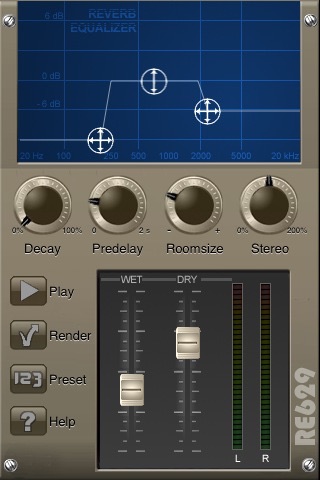
Add reverberation to your music. Simulate small intimate rooms or large concert halls. Reverb is being used to add reverb or echo to your recordings, to voice samples, any instruments or more complex samples and also mixdowns.
***To clear up a few misconceptions: Reverb delivers a very clean reverberation of your audio.
To increase the reverb intervals: increase the room size parameter
To increase the absorption of sound due to walls and carpets: increase the decay parameter. Note that 0 decay means no absorption and therefore total reflection
The equalizer is used to model what frequencies are reflected since different materials of walls, carpets etc reflect different frequencies. If you encounter problems, please visit the support forum and post a question/request. ***
Set room size and decay to adjust reflection time.
The greater the enclosed size of the room youre in, the longer the reverb time. This is of course true only to a certain extent. The larger the room or chamber, the louder your source signal needs to be to produce any significant level of reverb tail.
Set decay to influence how fast the sound waves are absorbed.
Predelay is the time between direct signal and start of reverb portion. The more space between you and walls or other reflective objects, the greater the predelay.
Model the reflections with a triband equalizer to adjust for different reflections at different frequencies.
Modify the stereo image of the reverbs to increase or decrease stereo width.
Set wet and dry volume separatly. And make sure to check the levels on the stereo level meter to prevent clipping.
Bounce your new created reverb to disc as 16 bit wav file.
Record your music via built in microphone.
Use AudioCopy and Paste to interchange music with apps like FourTrack.
Use the built in wifi server to transfer your music samples to and from your desktop computer.
There is a live mode available where only the reverberated samples are send to the output. 3 presets for convenience live performance.
Calculations are done internally using 32 bit floating point. The algorithm used was first proposed by Schroeder and Moorer. To compensate for the sometimes metallic reverbs a tri band equalizer has been added in series. Just filter out unwanted reflections to get the sound you want.



